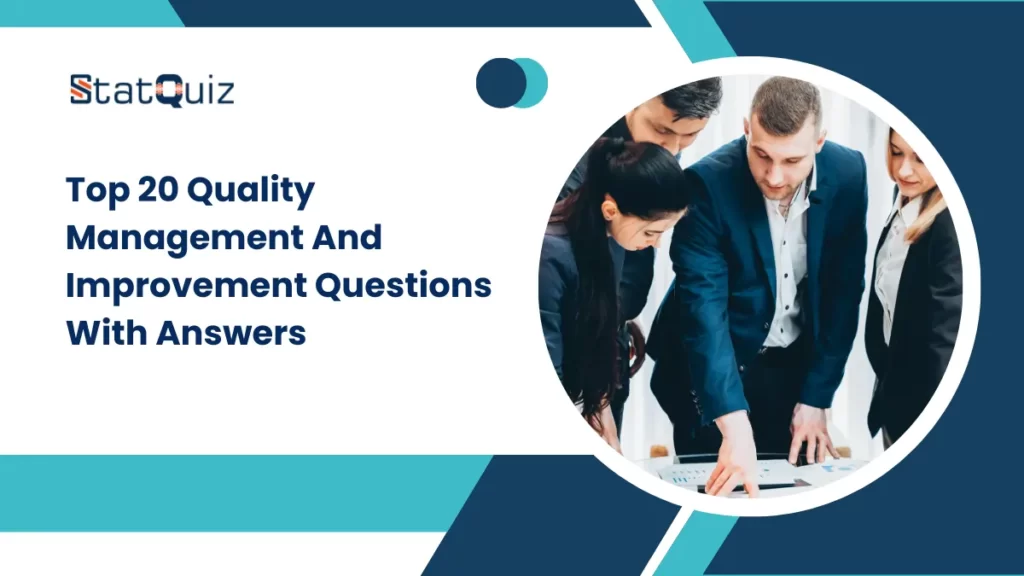Quality management and improvement can feel like a confusing maze of jargon and mind-blowing concepts. But fear not, fellow quality enthusiasts! We’re here to bust through the myths and simplify the science with our Top 20 Questions and Answers on Quality Management and Improvement.
In this blog, we’ll provide some questions and answers, from the basics of quality control to the hottest new trends in improvement. Think of it as your cheat sheet to mastering quality like a pro. So, whether you’re a seasoned pro or a curious newbie, grab your thinking cap and join us on this quality adventure!
Now, let’s move on to the Top 20 Quality Management And Improvement Questions With Answers
Q1. The house of quality is used to translate customer wants into engineering design variables. The linking or prioritizing of customer wants into engineered values occurs in what element?
a. Target values
b. Competitive analysis
c. Technical requirements
d. Relationship matrixQ2. Lean and Six Sigma are Both focused on Quality & Value for the customer?
a. True
b. FalseQ3. Benchmarking might be defined as which of the following:
a. An acceptable standard of achievement
b. Comparing a company's performance to a standard and then to another company's performance
c. A process for rigorously measuring one company's performance versus the best in class
d. industry practices that lead to negative performanceQ4. The Kano model is used to:
a. Describe takt time
b. Calculate rolled throughput yield
c. Measure supplier performance
d. Analyze customer requirementsQ5. The __ metric is your critical measure, it's the reason for your project, and it's your beacon. This metric is the single most important thing to understand in order for you to be successful
a. Project
b. Primary
c. Six Sigma
d. SecondaryQ6. The project charter will contain a business case, which can be defined as:
a. A reasoning for the redesign of a process or product
b. A short summary of the strategic reason for the project
c. A case study of the project proposal
d. The full arguments for the projectQ7. What is the Japanese word for waste? __
Ans – Muda
Q8. When selecting a project, first priority should be given to a project that:
a. Only affects employees in the work cell
b. The solution is readily apparent before the project is started
c. Has objectives that align with organizational goals
d. Is expected to be completed within 90 daysQ9. Six Sigma project methodology normally begins with what initial step?
a. Problem definition
b. Project charter
c. Champion approval
d. DefineQ10. A well written problem statement contains all of the following except
[ ] Baseline [ ] Goal
[ ] Gap [ ] COPQ
[ ] Timeline Reference [ ] Project Plana. Gap
b. Goal
c. COPQ
d. Baseline
e. Project PlanQ11. Which Six Sigma role is most likely to define objectives and set priorities for an improvement team?
a. Green Belt
b. Sponsor
c. Master Black Belt
d. Process OwnerQ12. Any action taken to reduce the probability and/or consequences of an adverse outcome from a development project is called:
a. Mitigation
b. Conflict resolution
c. Problem solving
d. BrainstormingQ13. A Six Sigma improvement team may be required to analyze customer data in order to define a project or evaluate the results of an improvement. Which of the following tools would be of greatest value?
a. Nominal group technique
b. Conflict resolution and communication techniques
c. Pareto and statistical analysis
d. Brainstorming and multivotingQ14. A process consists of three sequential steps with the following yields:
Y1 = 99.8, Y2 = 97.4, Y3 = 96.4
Determine the total defects per unit.a. 0.063
b. 0.069
c. 0.067
d. 0.065Q15. Arrange these C&E process steps into the correct order of execution.
[ 1 ] Affinitize or group the causes
[ 2 ] Brainstorm all potentials causes
[ 3 ] Evaluate
[ 4 ] Identify & define the effecta. 3 2 1 4
b. 4 2 1 3
c. 1 2 3 4
d. 2 1 4 3Q16. Review of purchase orders for quality requirements falls into which one of the following quality cost categories?
a. Internal Failure
b. Appraisal
c. External Failure
d. PreventionQ17. Pareto diagrams are used to:
a. Display causes in a graphical manner
b. Generate a large number of potential solutions
c. Focus attention on problems in priority order
d. Determine a cause-effect relationship between one or more variablesQ18. The most difficult stage for any team to work through is:
a. Performing
b. Storming
c. Norming
d. FormingQ19. Understanding, controlling, and improving an organization's processes to create value for all stakeholders is referred to as:
a. A SIPOC diagram
b. Business process management
c. The establishment of KPIVs and KPOVs
d. Process performance metricQ20. With regard to conditions on the work floor, which of the following should management consider to be the most valuable information source?
a. Downward flow (top-down)
b. Horizontal flow (across the organization)
c. Informal network
d. Upward flow (bottom-up)
Answers
- d
- a
- c
- d
- b
- b
- Muda
- c
- d
- e
- b
- a
- c
- d
- b
- d
- c
- b
- b
- d

